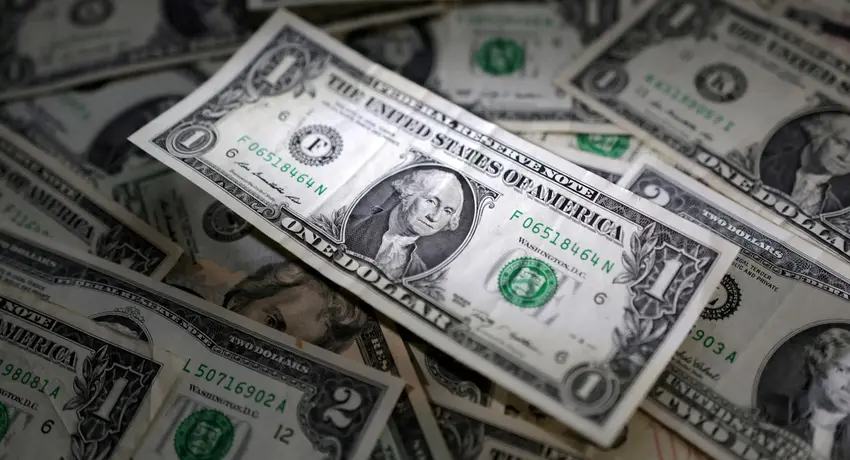The U.S. dollar continued to rebound on Friday, extending its upward momentum after the Federal Reserve signaled no urgency to cut interest rates this year. The greenback found fresh support from resilient labor market data and cautious risk sentiment in global markets.
At 05:25 ET (09:25 GMT), the U.S. Dollar Index (DXY) — which tracks the dollar against a basket of six major currencies — climbed 0.2% to 103.710. The index has now risen nearly 0.6% over the past two sessions, paring losses from a five-month low touched earlier in the week.
Dollar Finds Strength in Fed’s Cautious Tone
The Federal Reserve left interest rates unchanged earlier this week, as expected, but markets were focused on policymakers’ updated economic projections. The Fed now sees slower U.S. growth and stickier inflation through the remainder of 2025, but signaled no pressing need for rate cuts until clearer signs of economic deterioration emerge.
Adding to the dollar’s bullish sentiment, Thursday’s jobless claims data came in lower than expected, underscoring continued resilience in the U.S. labor market — a key determinant in the Fed’s policy stance.
“The Fed’s cautious stance coupled with strong job market signals leaves the door open for the greenback to extend its recovery,” analysts at ING noted in a morning research note. “With no major U.S. data releases today, we may see the dollar consolidate its gains before next week’s key inflation and retail sales prints.”
In the absence of fresh economic data, the Fed’s blackout period also officially ended, meaning policymakers could begin offering follow-up commentary on the FOMC’s outlook. However, ING believes most Fed officials may wait for additional data before adjusting their messaging.
Sterling Dips as Bank of England Hints at Flexibility
The British pound slipped on Friday as markets digested the Bank of England’s (BoE) dovish tilt at Thursday’s policy meeting. GBP/USD fell 0.3% to 1.2926 after the BoE left its benchmark rate unchanged but issued guidance suggesting it could accelerate cuts if labor market conditions worsen.
“There were two noteworthy aspects of the BoE’s latest meeting,” ING analysts commented. “First, Catherine Mann’s surprising shift from the hawkish camp to support holding rates, and second, the acknowledgment that weaker jobs data could fast-track disinflation conclusions and lead to earlier rate cuts.”
The pound, which has benefited recently from relatively high interest rates and strong wage growth in the U.K., is now facing downside risks as policymakers prepare to ease in response to a potential cooling labor market.
Markets are now pricing in a higher probability of rate cuts from the BoE later this year, further weighing on sterling sentiment.
Euro Pressured by Trade War Fears and Lagarde Comments
EUR/USD also edged lower, trading down 0.1% at 1.0836. The euro came under pressure after European Central Bank (ECB) President Christine Lagarde highlighted the potential economic fallout from an escalating trade war between the eurozone and the United States.
Lagarde warned that a proposed 25% tariff by the U.S. on European imports could shave 0.3 percentage points off eurozone GDP growth in the first year, and up to 0.5 percentage points if Europe retaliates.
The prospect of a trade conflict with Washington is weighing on the euro, which is already contending with sluggish economic growth across the bloc.
“The next major support for EUR/USD is likely the 1.0725 level, coinciding with the 200-day moving average,” ING noted. “This is a key benchmark for assessing whether the greenback’s rebound will sustain and further pressure the euro.”
Yen Slides Despite Upbeat Inflation Data
In Asia, the Japanese yen weakened even after data showed inflation in February exceeded expectations. USD/JPY traded 0.4% higher to 149.39, with the yen’s bearish trend persisting despite mounting evidence that the Bank of Japan (BOJ) could hike rates in May.
Japan’s core consumer price index (CPI) rose further above the BOJ’s 2% target, bolstered by strong wage growth and personal spending.
“The stronger inflation data confirms that the BOJ’s forecast of a sustainable inflation path remains intact, but for now, yen traders remain cautious amid broad dollar strength,” said a Tokyo-based FX strategist.
Even with rate hike expectations rising for the BOJ’s May meeting, the yen remains vulnerable to the dollar’s broader recovery and persistent yield differentials between U.S. Treasuries and Japanese government bonds.
Yuan Edges Lower Amid China Stimulus Focus
Meanwhile, the Chinese yuan continued to drift lower, with USD/CNY inching up to 7.2494. The yuan’s decline reflects growing expectations that Beijing will roll out additional fiscal and monetary stimulus to shore up its faltering economic recovery.
While Chinese authorities have already introduced some targeted measures, markets are still anticipating larger-scale stimulus, especially in sectors like real estate and infrastructure.
Traders are also keeping an eye on U.S.-China trade tensions, which could exacerbate risks for the yuan if geopolitical frictions intensify.
Global FX Market Eyes U.S. Data and Trade Developments
With major central bank meetings out of the way this week, traders are now turning their attention to upcoming U.S. data releases and global trade developments that could further shape currency markets.
Key areas of focus include:
- U.S. Inflation Data (CPI & PPI): Markets will be watching closely to gauge whether inflationary pressures are receding fast enough to support the Fed’s dovish projections.
- U.S. Retail Sales: A strong reading could further reinforce dollar strength by underscoring resilient consumer demand.
- Trade War Developments: Escalating trade tensions between the U.S. and its key partners, including Europe and China, could weigh on risk sentiment and trigger safe-haven flows into the dollar.
- BOJ Policy Outlook: Markets will also monitor Japanese policymakers’ comments to confirm whether a May rate hike is on the table, which could affect yen positioning in the coming weeks.
Conclusion: Dollar Maintains the Upper Hand, But Volatility Remains Ahead
The dollar’s ability to extend its rebound reflects a combination of resilient U.S. economic data, the Fed’s cautious approach to easing, and renewed risk aversion linked to potential trade conflicts.
While sterling and the euro face fresh downside pressures from dovish central bank signals and trade-related headwinds, the yen’s trajectory hinges on how aggressively the BOJ tightens monetary policy relative to global peers.
For now, the greenback looks well-positioned to maintain its gains in the near term, especially if upcoming U.S. data supports the Fed’s patient stance on rate cuts.
Disclaimer: This article is for informational purposes only and does not constitute financial advice. Always conduct your own research before investing in Gold Market.



